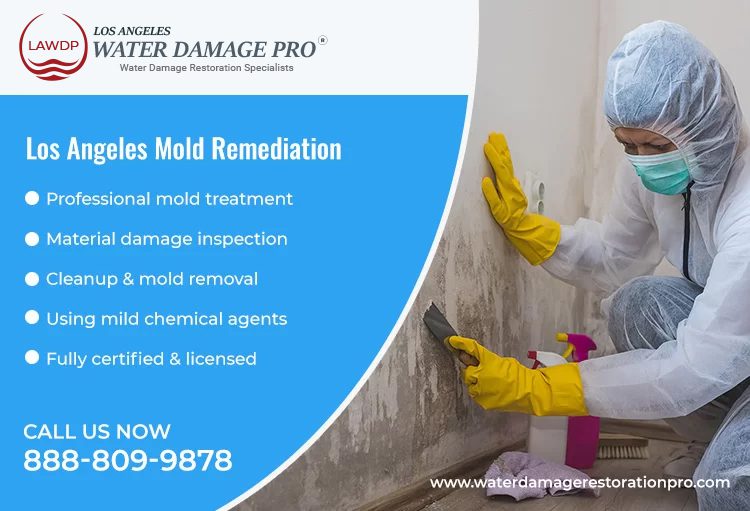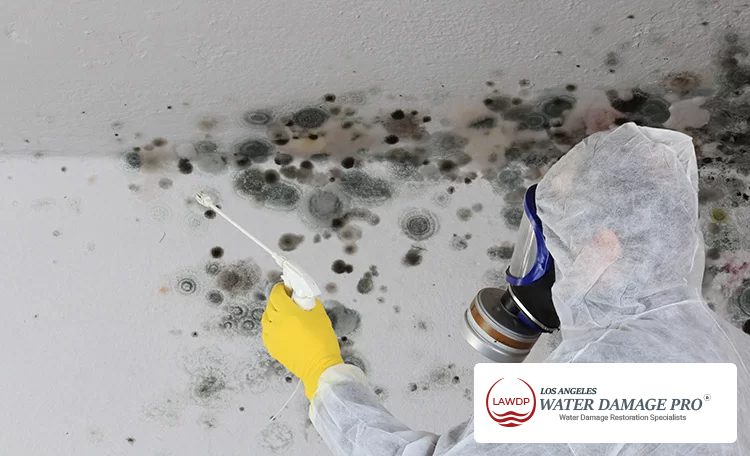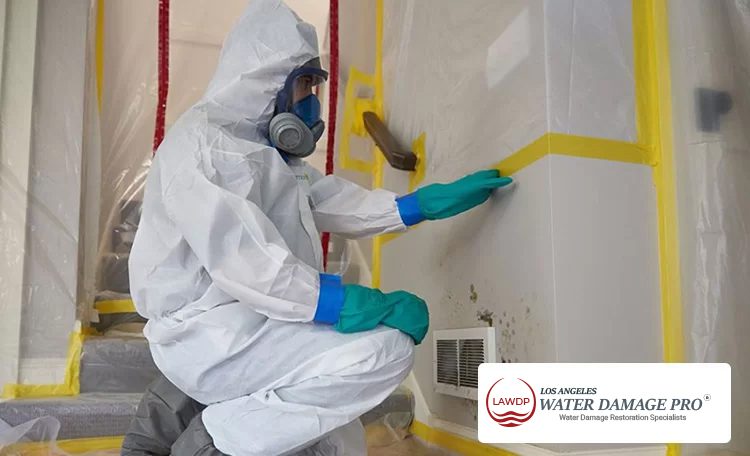- 24/7 Water Damage Emergency
- Licensed and Insured
- FREE Estimates
- Direct Insurance Billing
- Insurance Claims
It is kind of an absolute necessity in homes that are situated in a region that receives a fairly decent amount of rainfall in a year and has a big contrast or difference in high and low temperatures. The growth of mold, mildew, fungus, algae and moss grows in places where there’s moisture, wetness, dampness and heat, apart from low temperature.
Such weather conditions accelerate the process of mold growth on surfaces like wood, concrete, as well as metal. This phenomenon needs to be prevented at any cost to save a structure from rot and decay.
At Water Damage Restoration Pro, we’ve got experts for mold remediation and mildew treatment at home interiors & exteriors that have grown old, become outdated and faced the extremes of weather conditions, by being exposed to the elements for years.
Mold requires humidity, moisture and shade to grow. And, homes that have turned old and have formed cavities, tend to speed up the process of mold growth on the surface of wood or concrete. This is when structural decay starts and your home becomes structurally compromised if proper action is not initiated on time.

If proper Los Angeles mold remediation measures are not taken on time, it would result in complete decay of the materials, structures and components that are susceptible to mold & mildew growth. You can always feel free to call us at 888-809-9878 and learn more about our mold remediation techniques.
We only use mild chemical agents that produce no effect on the inhabitants of a house. As there are different types of molds and their varieties, we use different procedures. Lets’ understand where mold growth occurs.

The growth of molds can bring with it, a variety of health problems and issues, if not tackled in a proper and scientific way. It can lead to serious bodily ailments and create a health scare at home, especially if there are infants, toddlers, elderly parents, ailing family members and pets at home.
Therefore, you need to go for complete removal of molds from a house or a building that has grown old, suffered weather damages and is lying in a neglected state for years, without any previous mold, fungus, bacteria or algae treatment.
This is why a mold infestation treatment is a ‘must do’ job. If not done on-time, it can lead to physical and bodily ailments like serious kind of skin allergies, eye allergies, poor air quality at home interiors, irritants in the air, cause continuous sneezing, mycotoxins and even lead to chronic diseases.
So, if you’re not sure whether your house is infested with mold, always call an expert like us to detect the problem and get it cured at the earliest before it spreads to other areas of the house.
Here are some health hazards that can be caused by mold growth
| Disease | Description | Symptoms |
| Allergic rhinitis | An allergic reaction to mold spores that become airborne and are inhaled. | Sneezing, runny nose, itchy eyes, nasal congestion, coughing |
| Asthma | Inhaling mold spores can trigger an asthma attack or worsen existing asthma symptoms. | Wheezing, coughing, shortness of breath |
| Hypersensitivity pneumonitis | An immune system reaction to inhaling mold spores over a long period of time. Can lead to lung damage if left untreated. | Cough, shortness of breath, fever, chills, muscle aches |
| Invasive aspergillosis | A serious infection is caused by inhaling the spores of the Aspergillus fungus. Can be life-threatening, especially for those with weakened immune systems. | Fever, cough, chest pain, shortness of breath, fatigue |
| Mycotoxicosis | Toxic substances produced by certain types of mold can cause a range of symptoms if ingested or inhaled in high doses. | Headaches, dizziness, muscle pain, fatigue, gastrointestinal problems |
While it may be tempting to grab a cloth and wipe away the mold, stop. The mold you see means it is growing spores, and touching it can release these spores into the air. According to the CDC, you should treat mold right away.
Try to stay away from the area. Where mold grows, the density of mold spores in the air is higher and could cause congestion or other problems, such as headaches and dizziness.
Turn off your HVAC because the last thing you want is to attract mold spores into your air circulation system.
Call a professional for mold removal. We at Water Damage Restoration Pro use mold remediation methods based on current industry standards. Our training and team will make sure the issue is resolved the right way.
| Moss remediation | Treating moss with mild chemicals |
| Mildew remediation | Treating mildew with soft agents |
| Fungus remediation | Manually cleaning by fungus scratching |
| Algae remediation | Scratching & treatment with diluted chemicals |
No two mold problems are exactly alike, but they all require the same care and precision. Our mold remediation technicians are qualified to inspect and remove mold from residential and commercial properties.

The first step in the mold removal process is asking for help. In order to solve the issue, you must get in touch with the our local remediation team. It is necessary to call someone with experience because cleaning mold is not an easy task.
It takes many chemicals and methods to completely get rid of mold from your homes. Once we understand your situation, we can provide you with the best possible solutions.
Professional mold cleanup procedures include inspection of the contaminated area. Until and unless the mold removal team is not sure how serious the situation is, we don’t get started. The crew discovers the issue’s origin.
Once our team is sure of the extent of the damage, we begin to make a proper plan on how to get rid of the mold. To do this, the mold removal team ensures that our assessment is correct. After getting confirmation of our findings, we work on different things like:
Cleaning specialists not only focus on mold cleaning services but also make sure that the spores do not spread. The main goal of calling our people is to keep your home free of mold.
Therefore, our experts take all necessary steps to save you and the uninfected areas of your residence from contamination. Mold spreads quickly in moist conditions, so the infected patch is isolated.
It is easy for the spores to spread in the air. Therefore, along with the polluted space, the air must also be cleaned. Air filtration is a mandatory part of these remedial steps.
People often need to remove the entire mold-affected interior to get rid of the problem permanently. From drywall to carpeting and even furniture, anything can be affected by mold. Therefore, you will need to remove them if necessary.
Using powerful chemicals, all mold spores and patches are removed. Any area showing signs of mold is thoroughly cleaned. To clean mold, technicians wipe down the area with a rag and then use detergent solutions.
Sometimes rubbing is necessary to make sure no spores remain in the infected patch. The patch is allowed to dry after it is completely clean.
During the drying process, the remaining moisture also dissipates. After completing the task, a team of cleaners disinfects the entire area.
After completing all the steps, it’s time to put things back. Our experts then finally remove covers and materials from the location.
Overview of the Different Types of Mold Remediation Services
Here are the services that you can get for mold remediation in Los Angeles along with their costs and the time taken
| Type of Service | Description | Average Cost | Time Taken |
| Surface Mold Removal | The process of removing visible mold growth from the surface of materials and objects. | $500 – $2,500 | 1-2 days per room |
| Air Purification | The use of technology or methods to clean the air and reduce contaminants or pollutants in an indoor environment. | $1,000 – $5,000 | 1-2 days per system |
| Structural Mold Removal | The removal and remediation of mold growth from the structural components of a building, such as walls, floors, and ceilings. | $2,500 – $10,000 | 1-2 weeks per room |
| Encapsulation | A process that involves the use of a specialized coating or sealant to prevent mold from growing or spreading. | $2,000 – $8,000 | 1-2 days per room |
| Complete Mold Remediation | A comprehensive approach to addressing mold issues that involves identifying the source of the mold, removing it, and taking steps to prevent it from returning. | $5,000 – $20,000 | 1-3 weeks per project |
When you smell something musty & foul, and see greenish and dark patches, it is definitely mold growth, which occurs as a result of excess moisture and exploration of continuous water. This is when you need to call a water damage restoration specialist like us to get rid of this issue at home.
Since mold remediation involves the process of removing harmful mold & mos growth, it includes certain activities and processes such as inspection, mild chemical treatment, manual removal, sanitizing and extensively cleaning the infestation, making the area look fresh again.
It depends on the type of mold infestation and the extent of damage it has caused to any surface. Generally, any mold removal process takes 1-5 days, but again it depends on how much mold is present and where it is growing.
You can either manually scrub the surface with a rough scrubber, peel the wood or use a mixture of water and bleach mold cleaner to effectively remove or wash away the infestation from any surface or corner. You can use a brush for corners and a flat scrubber for the surface. Allow the bleach to penetrate the surface.
Our mold remediation estimate will include a detailed assessment of the affected area, the type and extent of the mold growth, and the necessary steps to remediate the mold problem. Here are some of the items that are normally included in our mold remediation estimate:
Insurance: If the mold remediation is covered by insurance, the estimate should include the estimated cost of the work, including any deductibles or out-of-pocket expenses.
Yes, we do offer cleanup services after mold remediation. The cleanup process after mold remediation usually involves removing any remaining mold spores, debris, and contaminated materials from the affected area.
In addition to the cleanup, we also provide recommendations for preventing future mold growth and improving indoor air quality.
To prevent mold from coming back, you need to address the underlying causes of moisture and humidity that contribute to mold growth. Here are some steps you can take:
Fix any water leaks or sources of moisture: Inspect your home for any leaks in plumbing, roofs, or windows that could be causing moisture buildup. Repair any leaks promptly to prevent mold growth.
Improve ventilation: Good ventilation is important to reduce humidity levels and prevent moisture buildup. Use exhaust fans in bathrooms and kitchens to vent moist air outside. Open windows and doors to improve air circulation in the home.
Reduce humidity levels: Maintain indoor humidity levels between 30-60% to prevent mold growth. You can use dehumidifiers to remove excess moisture from the air.
Clean and dry wet areas promptly: If you experience any water damage or flooding, clean and dry the affected areas promptly. Use fans and dehumidifiers to speed up the drying process.
Use mold-resistant products: Consider using mold-resistant paint, drywall, and insulation in areas that are prone to moisture, such as bathrooms and basements.
Regularly clean and maintain your home: Regularly clean and vacuum your home to remove any dust, dirt, and other debris that could contribute to mold growth. Replace air filters regularly to ensure good air quality.